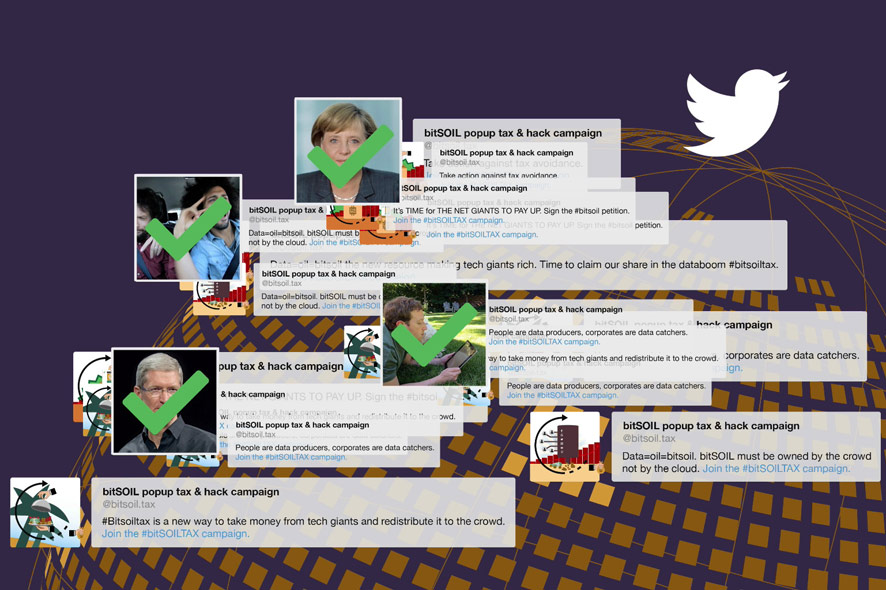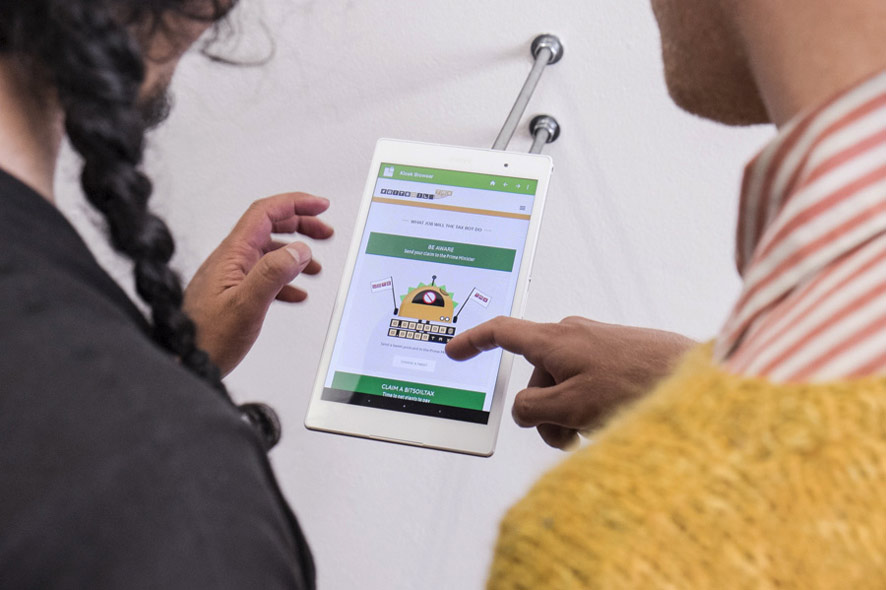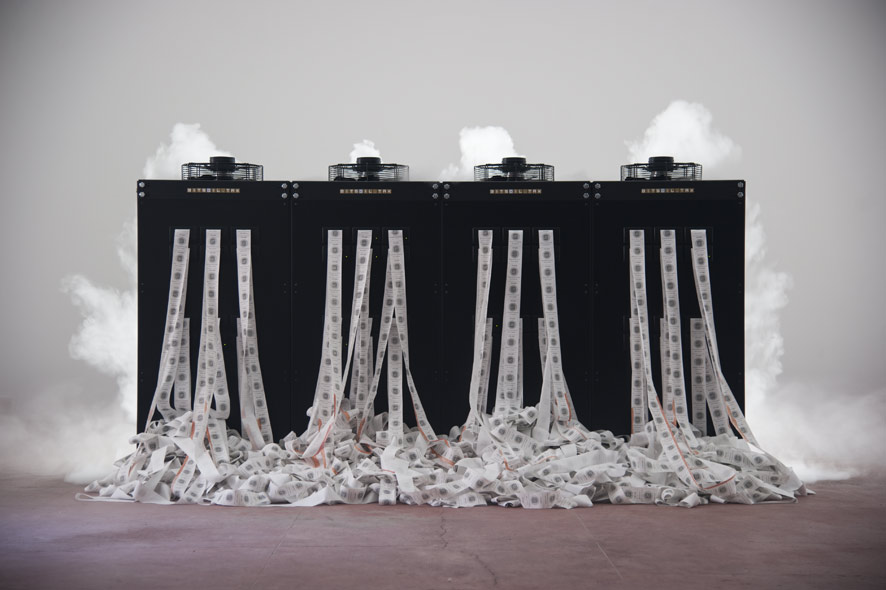Whoever writes on Twitter about “Apple”, “Cash”, “Data” or other terms may have been already invited by one of the bots to join the BitSoil Popup Tax & Hack Campaign. The Internet installation by LarbitsSisters, which won the 2018 Prix Ars Electronica in the Interactive Art+ category, has set itself the goal of encouraging Internet users to join forces and jointly create new “BitSoil” – in which their activities on the Web again generate valuable data.
Why did you decide to launch the BitSoil Popup Tax & Hack Campaign?
LarbitsSisters: We launched the Bitsoil Popup Tax & Hack Campaign to provide the anonymous mass of internet users with a strategic tool to address the current imbalance in the digital economy and to make a claim on the digital wealth they have helped produce and that is currently concentrated in the hands of big internet companies. The campaign encourages (net)citizens to join the resistance and take back power when it comes to personal data. The goal is to make a collective claim on tech giants to pay their fair share of tax on the use of data that bring them such enormous profits.
Our previous workspace was located opposite the Maximiliaanpark in Brussels where many refugees resided. There we learned about the circumstances these people lived in and the EU’s management of the migration crisis. This situation stirred our interest and critical engagement and lead to the project EU4you, of which BitREPUBLIC and the BitSoil Popup Tax & Hack Campaign are a continuation.
These migrants found themselves in a precarious position outside of the prevailing social security structures that nation states provide to only a selection of people. We simultaneously saw the massive increase of digital wealth that was daily produced by the anonymous crowd on the internet and that is securely and unjustifiably concentrated in the hands of a number of big internet companies. This imbalance led us to think of an alternative social security model that actually took the unevenly distributed digital wealth into account. That’s how BitREPUBLIC was created; a digital structure transcending the borders of nation states and connecting the offline and online worlds in a digital social system.

Credit: Larbitslab
Which goal do you pursue with this project and to whom is the campaign directed?
LarbitsSisters: The goal of the Bitsoil Popup Tax & Hack Campaign is to propose a more inclusive model for the data economy and make people aware of possibilities in this direction. Currently a very large part of the world population produces data. This digital resource for which we coined the word bitsoil – bits as once oil was the new black gold – are collected by tech giants who then make enormous profits on the subsequent selling of these resources to advertising companies and other third parties.
“The value of these data has long outstripped the free services offered in return by these internet giants. This makes for an inequality, as the surplus value is not shared with the producers of this value, the anonymous internet crowd. The Bitsoil Popup Tax & Hack Campaign serves to sensitize people to questions of wealth distribution in the digital economy that up until now have not been thoroughly thought through.”
The campaign hence is directed to the anonymous internet user, the 99%, who is asked to join forces with others in the same position and thereby create a collective tax claim directed at the big tech companies and world leaders who actually are in a decision making position as it comes to digital matters.
What exactly do you understand by the bitsoil hypothesis behind this project?
LarbitsSisters: Bitsoil is the new black gold of the digital economy. It consists of the data generated on a daily basis by the anonymous crowd on the internet. The value of these data is enormous and up until now only big tech companies have benefited from it. Just like once the valuable resources that were found in mines, the bitsoil is at the basis of the current digital economy.
A Google search, a post or like on Facebook or Twitter are activities that generate data and value. Can this digital capital be recuperated and brought back into the hands of those who produced it? Can we employ the bitsoil currency to attain a more balanced redistributive system? Can we bring back equilibrium to the digital economy in which wealth is now concentrated in the hands of a few large businesses?
The Bitsoil Popup Tax & Hack Campaign proposes to claim a micro-tax on every action performed by internet users. The data-servers of the project track participant’s digital traces on the campaign’s platform and accord them a value. The tax that is then calculated and collected by the datacenter is the basis for the bitsoil currency, that is redistributed (among participants) in the BitREPUBLIC. Hence a collective digital social security system is proposed.

Credit: Larbitslab
Why is exactly the bitsoiltax one tax for all?
LarbitsSisters: BitREPUBLIC and the Bitsoil Popup Tax & Hack Campaign are a blueprint for an alternative taxation and redistribution system for an all inclusive digital economy that surpasses borders of prevailing nation state structures that leave out those who do not comply to a certain profile, notably refugees and migrants.
Bitsoil is generated on the basis of actions performed by users on social media platforms such as Twitter. This value is subsequently distributed through a new tax mechanism across all those who together make up the BitREPUBLIC, regardless of personal characteristics such as gender, origin, level of education et cetera.
The campaign enables those who join to claim their fair share and to hold internet companies, world leaders and politicians accountable for the disequilibrium in the digital economy and to make the campaign gain momentum by pointing friends and acquaintances to it. The value on bitsoil belongs to data producers.
You use technologies such as Blockchain, Virtual Private Networks, Bots and Natural Language Classifier from IBM. Where and how are they used?
LarbitsSisters: More than a Virtual Private Network the tweets of the bots are rooted through Tor. Tor is basically an onion network. This network isn’t just a VPN, rather a worldwide series of nodes and machines running Tor and that route your web traffic through them and mask your IP address and thus your location. That is what makes Tor so secure. No one knows the complete circuit through which the tweets travel. All nodes in between the route are hidden, thus the receiver does not have a clue about who is tweeting. So Tor is excellent for securing privacy and to guarantee complete anonymity of the campaigners. There is no way to trace back to them nor to the bots that are tweeting for them.

Credit: Lumin
The Bitsoil Popup Tax & Hack Campaign is essentially a campaign led by social media bots. It’s a campaign on Twitter and for the campaign basically two kinds of bots were designed, prospector- and propaganda bots as well as tax collector bots. The role of the prospector- and propaganda bots is to endlessly stroll Twitter to spot users account on a set of predefined datasets of keywords and to trigger twitter users to join the campaign. This is where IBM’s Watson’s Natural Language Classifier technology comes in. AI-Watson Natural Language Classifier Service is typically a cloud-based AI service. The Natural Language Classifier technology and Watson’s computational capability has been particularly helpful here. The service applies cognitive computing techniques to classify and to recognize patterns in short text inputs such as tweets and to return corresponding tweets with a confidence score. This helped us to train bots to detect tweets that are relevant to the campaign.
Different from the prospector- and propaganda bots are the tax collector bots. They operate downstream. Just like the taxman which is the person who collects unpaid taxes from other people or corporations, tax collector bots have been designed to troll net giants, politicians and world leaders with tax-claim postcards. The tax collector bots are equipped with a little script that counts and converts each action performed by the bots into bitsoil. Anyone can design their own tax collector bot or even band of tax bots on the platform of the campaign. The bitsoils thus generated are then redistributed across the wallets, each one of which represents a citizen of the BitREPUBLIC.
In this project, the blockchain – the technology behind the bitcoin – intervenes on a more conceptual level to explore the possibility of a new wealth redistribution system. We explored the technology in a critical and strategic way to surpasses traditional structures of nation states and tried to put in place a mechanism that deploy to a certain extent fundamental human rights, such as the right to work and move freely, for those who find themselves in deprived positions.

Credit: Larbitslab
Your project moves between the online and offline world, between public and private fields. What could be the links between these worlds and fields?
LarbitsSisters: With BitSoil Popup Tax & Hack Campaign, online and offline worlds flow into each other to create the BitREPUBLIC, an environment where bitsoil is redistributed across its citizens. The installation offline consists of a series of block-modules that functions as datacenter, processing data and distributing bitsoils, and is equipped with tiny thermal receipt printers that show the continuous generation of value by printing tickets with the current amount of bitsoils on them.
All online activity by the bots during the campaign and on the campaign’s platform is converted offline into fysical bitsoil currency, rendering the immense value of data palpable for the public. By linking the digital and the fysical, the implications of current data economy and possible alternatives, actually can be envisioned by visitors. One can imagine a person, perhaps a refugee, pick up a bitsoil ticket from the printers, and walk to a local shop to provide for the day’s food.
The online platform transcends national borders and is continually accessible. The offline bitsoil.tax installation embed this digital structure in local life and activity. Organizations and institutions can host the work, thereby linking the online project to their respective local surroundings through rendering it visible and by inviting the public to participate.
Please note: The installation “BitSoil Popup Tax & Hack Campaign” will be part of the CyberArts exhibition at OK in Linz, which will open at the same time as the 2018 Ars Electronica Festival on September 6, 2018!

Since 2010 social media researcher Bénédicte Jacobs and media artist Laure-Anne Jacobs form the artist duo LarbitsSisters. The work of Brussels-based duo is situated at the crossroads of art, technology and social systems. Their collaboration grew out of a shared fascination on new media, merging research and artistic practice onto projects in which concepts such as traceability, data processing, network analysis, algorithms, automation and interactivity are explored and discussed. Their work process focuses on the creative drives and patterns in digital media.
